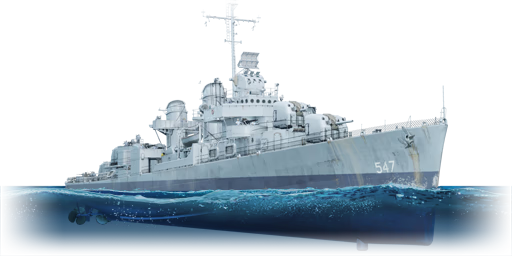


The USS Cowell was a member of the Fletcher-class destroyers, the first generation of destroyers developed by the U.S. after the disintegration of the Washington and London Naval Treaties during World War II. The Fletcher class was meant to be larger and carry more armament due to dissatisfaction with earlier destroyer classes. Cowell was named for US Navy officer John G. Cowell. She was laid down on 7th September 1942 and commissioned on 23rd August 1943. She spent her entire WWII career in the Pacific, participating in carrier screen force, escort duties, and anti-aircraft duty. On 13th October 1944, during the Battle of Leyte, she provided light, power, and pumping facilities to two torpedoed cruisers: USS Canberra and USS Houston. Cowell escorted the crippled ships to safety and then returned to screen the carrier force once again. During the Battle of Okinawa, she was on radar picket duty which brought her a Presidential Unit Citation. On 22nd July 1946, she was placed into reserve and later reactivated for the Korean War. She escorted Iowa-class battleship USS Missouri to bombard North Korean positions around Wonsan harbour. For her WWII and Korean War service, she received a total of thirteen battle stars. After the war, she spent the remainder of her US Navy career exercising until she was decommissioned on 17th August 1971 and sold to the Argentinian Navy as ARA Almirante Stormi. She was sold for scrap in 1982.
USS Cowell was introduced in Update 1.77 "Advancing Storm", initially purchasable as a pre-order pack in the Gaijin store to access the Naval Closed Beta Test. A Fletcher-class destroyer in the United States line, the Cowell is in the same class-line as the family ship USS Fletcher. The first statistical difference between the Fletcher and the Cowell is the armament, with the Cowell having four more turrets of 40 mm Bofors autocannons, and having one more additional turret of 20 mm autocannons.
USS Cowell was removed from the store in May 2020. It was still available on the PlayStation Store until War Thunder's 8th anniversary sale when it was removed from sale. The ship was temporarily made available for purchase in-game with GE for the annual "US Navy Birthday" mini-events in 2020, 2021, 2022, 2023 and 2024.
| Ammunition | Type | Armor penetration (mm) at a distance: | |||||
|---|---|---|---|---|---|---|---|
| 1000 m | 2500 m | 5000 m | 7500 m | 10000 m | 15000 m | ||
| HE | 36 | 36 | 36 | 36 | 36 | 36 | |
| Common | 119 | 94 | 64 | 44 | 32 | 28 | |
| SP Common | 146 | 116 | 79 | 55 | 41 | 34 | |
| HE-VT | 36 | 36 | 36 | 36 | 36 | 36 | |
| Belt | Belt filling | Armor penetration (mm) at a distance: | |||||
|---|---|---|---|---|---|---|---|
| 10 m | 100 m | 500 m | 1000 m | 1500 m | 2000 m | ||
| AP-T/HEFI-T | 81 | 78 | 69 | 61 | 55 | 50 | |
| AP-T/AP-T/AP-T/HEFI-T | 81 | 78 | 69 | 61 | 55 | 50 | |
| HEFI-T/HEFI-T/HEFI-T/AP-T | 81 | 78 | 69 | 61 | 55 | 50 | |
| Belt | Belt filling | Armor penetration (mm) at a distance: | |||||
|---|---|---|---|---|---|---|---|
| 10 m | 100 m | 500 m | 1000 m | 1500 m | 2000 m | ||
| HEF-T/AP-T | 34 | 32 | 26 | 21 | 18 | 16 | |
6 × Mk.6 mortar depth charge






 2 x (265 / 600) %
2 x (265 / 600) % 
 2 x 154 %
2 x 154 % 

Seakeeping |
|---|
Unsinkability | |
|---|---|
Firepower | ||
|---|---|---|